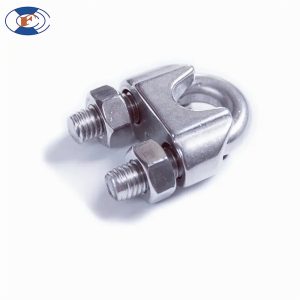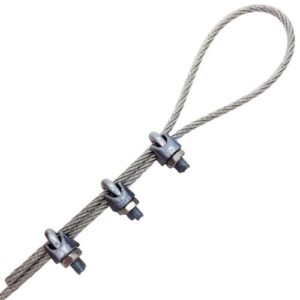Cable clamps, also known as wire rope clips, are essential components for securing the ends of wire ropes. They ensure the stability and safety of wire rope installations by preventing slippage. The number of clamps required depends on various factors, including the diameter of the wire rope and the intended use.
How to Install Wire Rope Clips
For detailed instructions on installing wire rope clips, Please refer to our previous article on “How to Use Wire Rope Clamps“. This guide will walk you through each step to ensure a secure and effective installation.
Overview of Wire Rope Clip Installation

Proper installation of wire rope clips is crucial for ensuring the safety and durability of your wire rope assembly. A wire rope clip typically includes a U-bolt, a saddle, and two nuts. Here’s a quick overview of the installation process:
Determine the Rope Size: Select the appropriate size of wire rope clip for your wire rope diameter.
Positioning the Clips: Place the first clip one saddle width from the dead end of the wire rope. Ensure the U-bolt is on the dead end and the saddle is on the live end.
Tightening the Nuts: Tighten the nuts evenly to the recommended torque.
Placing Additional Clips: Position the remaining clips along the rope, spaced evenly as per guidelines.
Re-tightening: After initial loading, re-tighten the nuts to the recommended torque.
Following these steps ensures the wire rope clips are installed correctly and can handle the intended load without slipping or causing damage to the wire rope.
How Many Cable Clamps on Wire Rope
The number of cable clamps needed on a wire rope is crucial for ensuring its securement and safety. The general guideline is based on the diameter of the wire rope. Here’s a quick reference table for the recommended number of cable clamps:
| Wire Rope Diameter (inches) | Number of Cable Clamps |
|---|---|
| 1/8″ | 2 |
| 3/16″ | 2 |
| 1/4″ | 3 |
| 5/16″ | 3 |
| 3/8″ | 3 |
| 1/2″ | 4 |
| 5/8″ | 4 |
| 3/4″ | 5 |
| 7/8″ | 5 |
| 1″ | 5 |
| 1-1/8″ | 6 |
| 1-1/4″ | 7 |
| 1-3/8″ | 7 |
| 1-1/2″ | 8 |
Detailed Explanation

Understanding the rationale behind the number of cable clamps required for various wire rope diameters helps ensure the effectiveness and safety of the installation.
For small diameter ropes (1/8″ to 1/4″), 2-3 clamps are sufficient. These ropes are typically used in less demanding applications where the loads are not excessively high.
For medium diameter ropes (5/16″ to 1/2″), 3-4 clamps are recommended. These ropes are commonly used in industrial settings where the load requirements are higher.
For larger ropes (5/8″ to 1-1/2″), 4-8 clamps are necessary. These ropes are used in heavy-duty applications such as construction, mining, and marine environments where safety is paramount. Each clamp adds an extra layer of security and ensures that the wire rope maintains its grip under load. Using the appropriate number of clamps is critical, especially in high-risk applications.
How Far Apart Should Cable Clamps Be?
The spacing between cable clamps is another critical factor for ensuring the effectiveness of the wire rope installation. Generally, cable clamps should be spaced six times the diameter of the wire rope. For example, if the wire rope diameter is 1/2 inch, the clamps should be spaced approximately 3 inches apart. Proper spacing helps in distributing the load evenly and prevents the rope from crushing or slipping under load.

Importance of Proper Spacing
Proper spacing of cable clamps is essential for several reasons.
Evenly spaced clamps ensure that the load is distributed evenly along the rope, reducing stress on individual clamps and the rope.
Correct spacing prevents the clamps from crushing the wire rope, which can weaken its structure and reduce its load-bearing capacity.
Additionally, proper spacing helps maintain the grip of the clamps on the wire rope, ensuring that the rope does not slip out of the clamps under load. Following the recommended spacing guidelines is crucial for the safety and longevity of your wire rope installation.
What is the Maximum Distance Allowed Between Cable Supports?
When installing wire ropes, it is also important to consider the maximum distance allowed between cable supports. Cable supports, such as pulleys or saddles, are used to prevent sagging and maintain the rope’s tension. The maximum distance between supports varies depending on the rope’s diameter and the load it carries. Generally, for a standard 1/2-inch wire rope, the distance should not exceed 15 feet. However, this can vary based on specific requirements and environmental conditions. Always follow industry standards and guidelines for your specific application.
Factors Affecting Maximum Distance
Several factors influence the maximum distance allowed between cable supports. Thicker ropes can generally span longer distances between supports compared to thinner ropes.
Heavier loads require more frequent supports to prevent sagging and maintain tension. Environmental factors such as wind, temperature, and exposure to chemicals can affect the rope’s performance and the distance between supports.
Specific applications may have unique requirements that dictate the maximum distance between supports. Following industry guidelines for support spacing is essential for maintaining the structural integrity and performance of your wire rope installation. For standard loads and conditions, spacing supports every 10-15 feet is typically sufficient for most wire ropes. For heavier loads, reducing the distance between supports to 5-10 feet may be necessary to prevent excessive sagging and maintain tension. In special applications, such as marine or construction environments, follow the specific guidelines provided by industry standards and the rope manufacturer.
Conclusion
Proper installation and spacing of cable clamps on wire ropes are crucial for safety and functionality. By following the recommended guidelines for the number of clamps and their spacing, you can ensure the securement and longevity of your wire rope installations. Additionally, understanding the maximum distance between cable supports helps maintain the rope’s integrity and performance. Regular inspections and maintenance are essential to ensure that the clamps and supports remain in good condition and perform their intended function.
FAQs About Wire Rope Clips
How do I determine the number of wire rope clips needed for a specific application?
To determine the number of wire rope clips needed, you should refer to the diameter of the wire rope and follow the general guidelines provided in this article. Always check the manufacturer’s specifications for precise requirements.
Can I use fewer cable clamps if my wire rope is not under heavy load?
No, it is not advisable to use fewer cable clamps than recommended. Even if the wire rope is not under heavy load, using the proper number of clamps ensures safety and prevents slippage.
What happens if cable clamps are not spaced correctly?
Improper spacing of cable clamps can lead to uneven load distribution, which can cause the wire rope to slip or become damaged. It is essential to follow the recommended spacing guidelines to ensure the rope’s stability.
Are there different types of cable clamps, and do they require different installation methods?
Yes, there are different types of cable clamps, such as U-bolt clamps and fist grip clamps. Each type may have specific installation methods, so it is important to follow the manufacturer’s instructions for the type of clamp you are using.
Can I reuse wire rope clips after removing them from an old installation?
It is generally not recommended to reuse wire rope clips because their integrity may be compromised after the initial installation. Always use new clips to ensure maximum safety and performance.
What materials are cable clamps made from, and how does this affect their use?
Cable clamps are typically made from materials such as galvanized steel, stainless steel, or malleable iron. The choice of material affects their corrosion resistance and suitability for different environments. For example, stainless steel clamps are preferred for marine applications due to their high corrosion resistance.
How tight should the nuts on the cable clamps be?
The nuts on cable clamps should be tightened to the manufacturer’s specified torque to ensure a secure grip without damaging the wire rope. Over-tightening can crush the wire rope, while under-tightening can lead to slippage.
Can I use cable clamps on synthetic ropes?
Cable clamps are specifically designed for wire ropes and may not be suitable for synthetic ropes. Synthetic ropes require different types of clamps or knots for securement. Always use the appropriate hardware for the type of rope you are working with.
How often should I inspect the cable clamps and wire rope in my installation?
Regular inspections are crucial for maintaining the safety and integrity of your wire rope installation. Inspect the clamps and wire rope at least every three months, or more frequently if the installation is subject to heavy use or harsh conditions.
What are the signs that cable clamps need to be replaced?
Signs that cable clamps need to be replaced include visible wear or corrosion, loosening of the nuts, deformation of the clamps, and slippage of the wire rope. Regular inspections can help identify these issues before they become critical.




